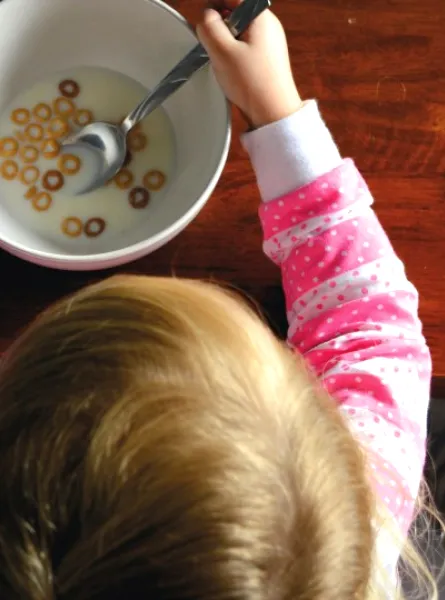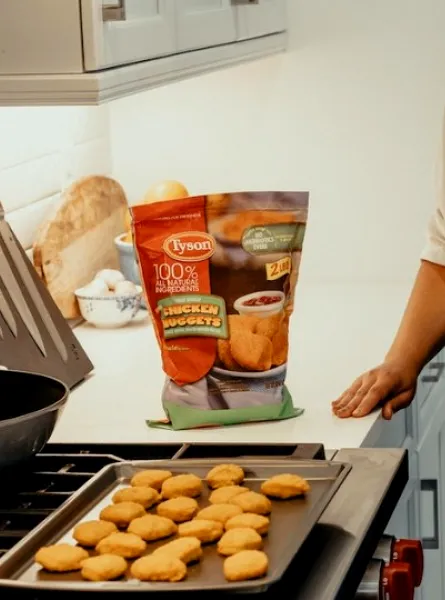
Baby-Led Weaning (BLW), a method of introducing solids where foods are offered in chunks, has been gaining popularity in recent years. Your patients may ask you about the risks and benefits associated with this new approach. Let's take a look at what the scientific literature says about this.
Considerations
If the infant sits upright without assistance, is able to bring food/objects to his or her mouth and turn his or her head from right to left, he or she appears to meet all of the criteria for initiating BLW (3, 4). At 6 months of age, the baby has also reached a stage of oral motor development that allows him or her to manage the change of texture from liquid to semi-solid or solid well (3). However, if your baby has a developmental delay or disorder, or if he or she was born prematurely, it is best to consult with your doctor before introducing solids (4, 5, 6). Some adaptations can be made so that baby can still be introduced to BLW (7).
Common Fears
Common concerns include the risk of choking, inadequate iron and zinc intakes and stunted growth in infants. An enhanced version of the BLW (Baby-Led Initiation to SolidS; BLISS) has been proposed to reduce these concerns. The proposed protocol provides additional support to new parents at various levels (8).
1. Deficiencies
With the BLISS approach, it is suggested that each meal include an iron-rich, energy-dense food in addition to a fruit or vegetable (8). No significant differences in iron and zinc intake and status were found between children fed pureed foods and those fed the BLISS/BLW approach (9, 10, 11). Moreover, anemia could also develop in a traditionally pureed child if the purees are predominantly made of low-iron foods.
2. Choking
The BLISS approach also advises on the texture and type of food offered to limit the risk of choking (8). According to the systematic review by Bergamini et al (2022), choking episodes reported by parents following the BLISS/BLW approach are no more frequent than in pureed-fed children (12). Furthermore, the frequency of exposure to chunky foods and lumpy purees appears to be inversely associated with the number of choking episodes reported with these textures. In addition, the events reported by all are specifically related to certain types of foods (slippery, firm, sticky, and peeling) and not to the texture of the food (pureed or solid) (13). It is also important to distinguish between choking and gag reflex. The latter is an airway protection mechanism that is quite common in babies introduced to BLW during the first few months of feeding (7). The incidents reported by parents could therefore sometimes be confused with the gag reflex. Finally, it seems essential that all parents, regardless of the approach chosen, be well informed about the precautions to take regarding the nature and format of the foods offered to minimize the risk of choking.
3. Adequate Growth
According to the systematic review by Bergamini et al (2022), it is not possible to conclude that BLW/BLISS would influence the growth of infants and young children. In fact, several studies report that the majority of children following the BLW or BLISS approach had normal weight at 12, 20, 24 and 78 months of age, respectively. However, given the disparity in protocols, age of subjects and techniques used for anthropometric measurements, interpretation of the results is limited (12). On the one hand, a randomized controlled trial reported that 98% of children fed using the BLISS approach had a normal weight at 12 months, whereas only 2% were underweight. In addition, no significant differences in head circumference and height were demonstrated (11). Furthermore, no significant differences were observed in energy intake in BLISS-fed children compared to traditionally fed children (14). These results suggest that the BLISS approach leads to adequate growth for the majority of children. That being said, before the age of 2 years, solid foods and purees are complementary to feeds. Breast milk and commercial infant formula can still account for more than one-third of total energy intake (1).
What are the benefits associated with BLW?
1. Prevention of obesity
Several groups cited in the systematic review by Bergamini et al (2022) have investigated the preventive role of BLW/BLISS in the development of obesity. However, the results are contradictory, which does not allow a firm conclusion to be drawn (12). In fact, only one randomized controlled trial in infants less than 12 months of age found more rapid weight gain in the traditional group compared with the BLISS group (11). However, these results were not significant (12). Notwithstanding, Brown and Lee (2015) report better listening to satiety cues as well as a lower response to food stimuli during the absence of hunger in children following EMR compared with parent-fed infants (15). Ellyn Satter's principle of shared responsibility allows the child to explore foods at his or her own pace, as the child alone decides how much and which of the foods offered are consumed (16). Further studies are needed to validate the impact of self-directed feeding on the prevention of the development of obesity in the long term, as several variables may interfere with the results (breastfeeding, birth weight, age at the beginning of the introduction of complementary foods, etc.) (15). Nonetheless, BLW appears to be a promising avenue given the influence of listening to satiety cues and self-regulating food intake on reducing the risk of obesity in childhood (17).
2. Food Repertoire
The only difference in dietary variety observed between BLISS and puree-fed children is the greater variety of fruits and vegetables consumed by self-feeding children at age 2 years (18). The exploratory component of the BLISS/BLW approach may have the effect of increasing the acceptability of foods to young children (19, 20, 21, 22). Thus, a child introduced to BLW may have a greater long-term food repertoire. Further studies evaluating differences in food preference and variety in children older than 2 years of age according to the method of solids introduction used are needed.
3. Motor Development
An introduction to independent feeding at 6 months of age provides more opportunities for infants to develop gross and fine motor skills (8). These more frequent exposures also allow children to acquire oral skills for managing different textures and types of food (20, 22). These skills could possibly reduce the risk of choking on chunky foods (5, 13).
Beyond the concerns, modified BLW (BLISS) appears to be as safe as purees for introducing solid foods to infants, with some advantages. However, additional studies on oral nutrient intakes are needed to completely rule out the risk of inadequate growth associated with this approach. It is essential that the family be well informed of the measures to be put in place to limit the risks and adapt the diet to the baby's particular needs.
A TeamNutrition nutritionist will be able to guide parents during this period of food exploration. Contact us to learn more about our services.
References:
- World Health Organization (2021). Infant and young child feeding. https://www.who.int/fr/news-room/fact-sheets/detail/infant-and-young-ch…
- Health Canada (2010, November). Dietary Reference Intakes. https://www.canada.ca/fr/sante-canada/services/aliments-nutrition/saine…
- Naylor, A.J. and Morrow, A.L. "Developmental Readiness of Normal Full Term Infants to Progress from Exclusive Breastfeeding to the Introduction of Complementary Foods," Wellstart International and the LINKAGES Project/Academy for Educational Development, 2001, pp. 1-44
- Public Health Agency (2020, February). Weaning made easy moving from milk to family meals. https://www.publichealth.hscni.net/sites/default/files/Weaning%20made%2…
- Wright, C. M., Cameron, K., Tsiaka, M., & Parkinson, K. N. (2011). Is baby-led weaning feasible? When do babies first reach out for and eat finger foods? Maternal & child nutrition, 7(1), 27-33. https://doi.org/10.1111/j.1740-8709.2010.00274.x
- Cameron, S. L., Heath, A. L., & Taylor, R. W. (2012). How feasible is Baby-led Weaning as an approach to infant feeding? A review of the evidence. Nutrients, 4(11), 1575-1609. https://doi.org/10.3390/nu4111575
- Rapley G. (2011). Baby-led weaning: transitioning to solid foods at the baby's own pace. Community practitioner : the journal of the Community Practitioners' & Health Visitors' Association, 84(6), 20–23.
- Daniels, L., Heath, A. L., Williams, S. M., Cameron, S. L., Fleming, E. A., Taylor, B. J., Wheeler, B. J., Gibson, R. S. et Taylor, R. W. (2015). Baby-Led Introduction to SolidS (BLISS) study: a randomised controlled trial of a baby-led approach to complementary feeding. BMC pediatrics, 15, 179. https://doi.org/10.1186/s12887-015-0491-8
- Daniels, L., Taylor, R. W., Williams, S. M., Gibson, R. S., Fleming, E. A., Wheeler, B. J., Taylor, B. J., Haszard, J. J. et Heath, A. M. (2018). Impact of a modified version of baby-led weaning on iron intake and status: a randomised controlled trial. BMJ open, 8(6), e019036. https://doi.org/10.1136/bmjopen-2017-019036
- Daniels, L., Taylor, R. W., Williams, S. M., Gibson, R. S., Samman, S., Wheeler, B. J., Taylor, B. J., Fleming, E. A., Hartley, N. K. et Heath, A. M. (2018). Modified Version of Baby-Led Weaning Does Not Result in Lower Zinc Intake or Status in Infants: A Randomized Controlled Trial. Journal of the Academy of Nutrition and Dietetics, 118(6), 1006–1016.e1. https://doi.org/10.1016/j.jand.2018.02.005
- Dogan, E., Yilmaz, G., Caylan, N., Turgut, M., Gokcay, G. et Oguz, M. M. (2018). Baby-led complementary feeding: Randomized controlled study. Pediatrics international : official journal of the Japan Pediatric Society, 60(12), 1073–1080. https://doi.org/10.1111/ped.13671
- Bergamini, M., Simeone, G., Verga, M. C., Doria, M., Cuomo, B., D'Antonio, G., Dello Iacono, I., Di Mauro, G., Leonardi, L., Miniello, V. L., Palma, F., Scotese, I., Tezza, G., Caroli, M. et Vania, A. (2022). Complementary Feeding Caregivers' Practices and Growth, Risk of Overweight/Obesity, and Other Non-Communicable Diseases: A Systematic Review and Meta-Analysis. Nutrients, 14(13), 2646. https://doi.org/10.3390/nu14132646
- Brown A. (2018). No difference in self-reported frequency of choking between infants introduced to solid foods using a baby-led weaning or traditional spoon-feeding approach. Journal of human nutrition and dietetics : the official journal of the British Dietetic Association, 31(4), 496–504. https://doi.org/10.1111/jhn.12528
- Taylor, R. W., Williams, S. M., Fangupo, L. J., Wheeler, B. J., Taylor, B. J., Daniels, L., Fleming, E. A., McArthur, J., Morison, B., Erickson, L. W., Davies, R. S., Bacchus, S., Cameron, S. L. et Heath, A. M. (2017). Effect of a Baby-Led Approach to Complementary Feeding on Infant Growth and Overweight: A Randomized Clinical Trial. JAMA pediatrics, 171(9), 838–846. https://doi.org/10.1001/jamapediatrics.2017.1284
- Brown, A. et Lee, M. D. (2015). Early influences on child satiety-responsiveness: the role of weaning style. Pediatric obesity, 10(1), 57–66. https://doi.org/10.1111/j.2047-6310.2013.00207.x
- Ellyn Satter Institute. « The Division Of Responsability In Feeding », 2022, repéré à https://www.ellynsatterinstitute.org/how-to-feed/the-division-of-respon…
- Johnson, S. L., & Birch, L. L. (1994). Parents' and children's adiposity and eating style. Pediatrics, 94(5), 653–661.
- Morison, B. J., Heath, A. M., Haszard, J. J., Hein, K., Fleming, E. A., Daniels, L., Erickson, E. W., Fangupo, L. J., Wheeler, B. J., Taylor, B. J. et Taylor, R. W. (2018). Impact of a Modified Version of Baby-Led Weaning on Dietary Variety and Food Preferences in Infants. Nutrients, 10(8), 1092. https://doi.org/10.3390/nu10081092
- Gill Rapley (2018) Starting solid foods: does the feeding method matter?, EarlyChild Development and Care, 188:8, 1109-1123, DOI: 10.1080/03004430.2016.1250080
- Boswell N. (2021). Complementary Feeding Methods-A Review of the Benefits and Risks. International journal of environmental research and public health, 18(13), 7165. https://doi.org/10.3390/ijerph18137165
- Fu, X., Conlon, C. A., Haszard, J. J., Beck, K. L., von Hurst, P. R., Taylor, R. W. et Heath, A. M. (2018). Food fussiness and early feeding characteristics of infants following Baby-Led Weaning and traditional spoon-feeding in New Zealand: An internet survey. Appetite, 130, 110–116. https://doi.org/10.1016/j.appet.2018.07.033
- Neves, F. S., Romano, B. M., Campos, A., Pavam, C. A., Oliveira, R., Cândido, A. et Pereira Netto, M. (2021). Brazilian health professionals' perception about the Baby-Led Weaning (BLW) method for complementary feeding: an exploratory study. Revista paulista de pediatria : orgao oficial da Sociedade de Pediatria de Sao Paulo, 40, e2020321. https://doi.org/10.1590/1984-0462/2022/40/2020321






